TOUR 2101: Analyzing Factors & Personalities in Global Tourism
VerifiedAdded on 2023/06/04
|8
|1884
|418
Report
AI Summary
This report provides a comprehensive analysis of the factors and conditions that encourage tourism in specific destinations like Saudi Arabia, India, and Israel, highlighting the significance of 'honeypots' and public amenities. It contrasts these with factors that deter tourism in other locations, such as animal abuse, exploitation, and political instability. The report utilizes Plog's Continuum to categorize tourist personalities, linking psychocentric tourists to popular destinations and allocentric tourists to less popular ones. Finally, it discusses future opportunities in tourism, driven by technology and international trade, and the challenges posed by political instability, poaching, and climate change. The analysis is supported by critical evaluation of various articles on tourism.
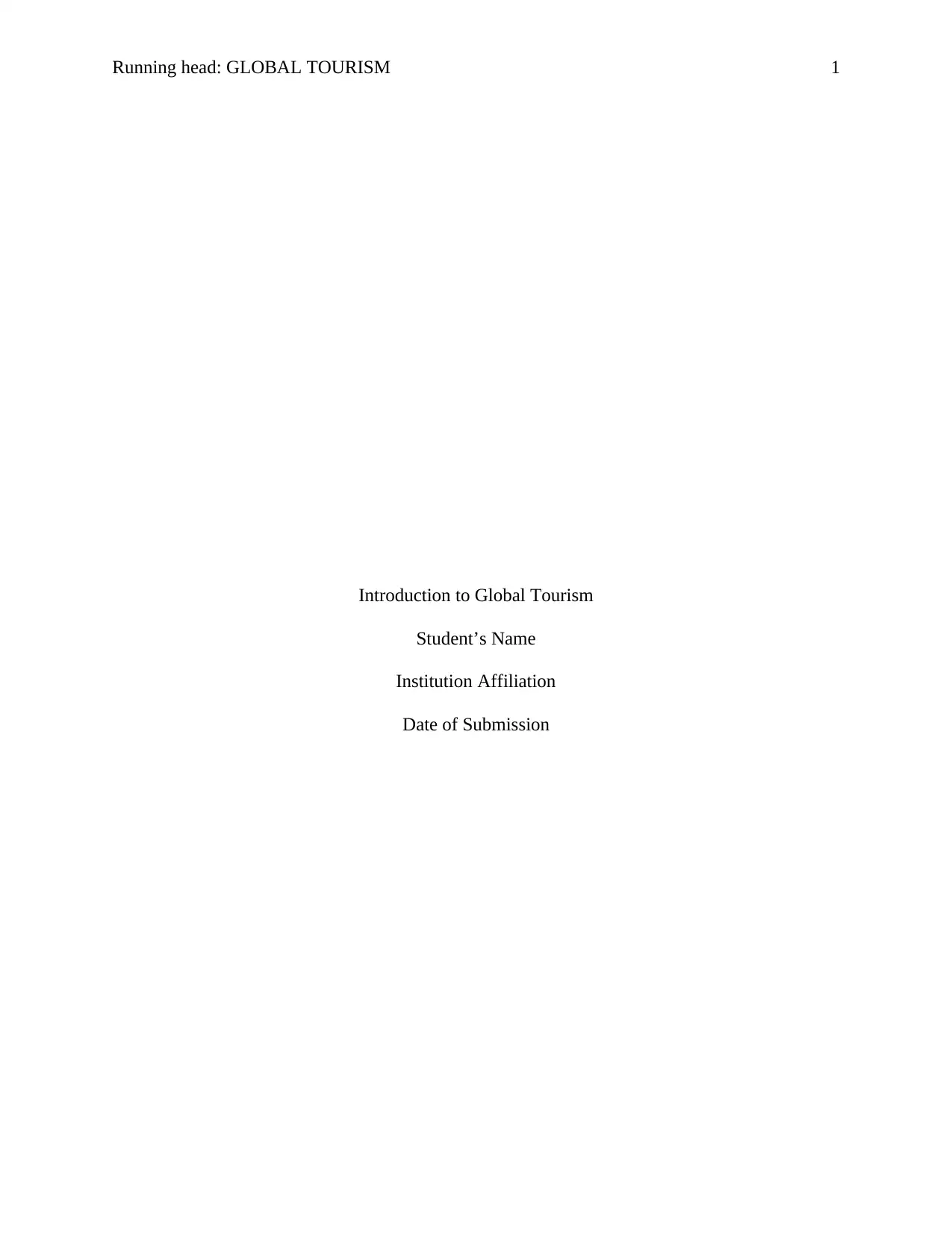
Running head: GLOBAL TOURISM 1
Introduction to Global Tourism
Student’s Name
Institution Affiliation
Date of Submission
Introduction to Global Tourism
Student’s Name
Institution Affiliation
Date of Submission
Secure Best Marks with AI Grader
Need help grading? Try our AI Grader for instant feedback on your assignments.
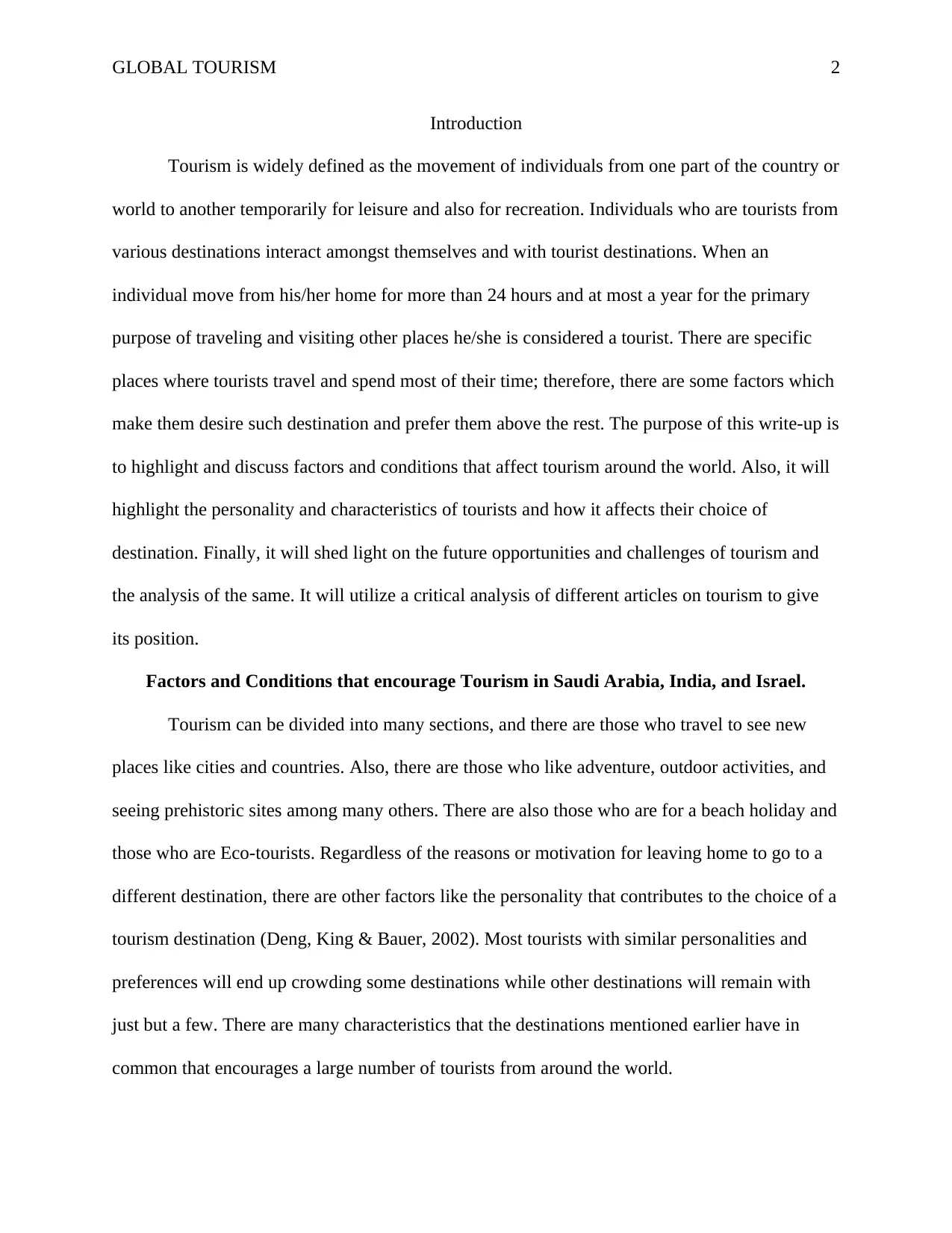
GLOBAL TOURISM 2
Introduction
Tourism is widely defined as the movement of individuals from one part of the country or
world to another temporarily for leisure and also for recreation. Individuals who are tourists from
various destinations interact amongst themselves and with tourist destinations. When an
individual move from his/her home for more than 24 hours and at most a year for the primary
purpose of traveling and visiting other places he/she is considered a tourist. There are specific
places where tourists travel and spend most of their time; therefore, there are some factors which
make them desire such destination and prefer them above the rest. The purpose of this write-up is
to highlight and discuss factors and conditions that affect tourism around the world. Also, it will
highlight the personality and characteristics of tourists and how it affects their choice of
destination. Finally, it will shed light on the future opportunities and challenges of tourism and
the analysis of the same. It will utilize a critical analysis of different articles on tourism to give
its position.
Factors and Conditions that encourage Tourism in Saudi Arabia, India, and Israel.
Tourism can be divided into many sections, and there are those who travel to see new
places like cities and countries. Also, there are those who like adventure, outdoor activities, and
seeing prehistoric sites among many others. There are also those who are for a beach holiday and
those who are Eco-tourists. Regardless of the reasons or motivation for leaving home to go to a
different destination, there are other factors like the personality that contributes to the choice of a
tourism destination (Deng, King & Bauer, 2002). Most tourists with similar personalities and
preferences will end up crowding some destinations while other destinations will remain with
just but a few. There are many characteristics that the destinations mentioned earlier have in
common that encourages a large number of tourists from around the world.
Introduction
Tourism is widely defined as the movement of individuals from one part of the country or
world to another temporarily for leisure and also for recreation. Individuals who are tourists from
various destinations interact amongst themselves and with tourist destinations. When an
individual move from his/her home for more than 24 hours and at most a year for the primary
purpose of traveling and visiting other places he/she is considered a tourist. There are specific
places where tourists travel and spend most of their time; therefore, there are some factors which
make them desire such destination and prefer them above the rest. The purpose of this write-up is
to highlight and discuss factors and conditions that affect tourism around the world. Also, it will
highlight the personality and characteristics of tourists and how it affects their choice of
destination. Finally, it will shed light on the future opportunities and challenges of tourism and
the analysis of the same. It will utilize a critical analysis of different articles on tourism to give
its position.
Factors and Conditions that encourage Tourism in Saudi Arabia, India, and Israel.
Tourism can be divided into many sections, and there are those who travel to see new
places like cities and countries. Also, there are those who like adventure, outdoor activities, and
seeing prehistoric sites among many others. There are also those who are for a beach holiday and
those who are Eco-tourists. Regardless of the reasons or motivation for leaving home to go to a
different destination, there are other factors like the personality that contributes to the choice of a
tourism destination (Deng, King & Bauer, 2002). Most tourists with similar personalities and
preferences will end up crowding some destinations while other destinations will remain with
just but a few. There are many characteristics that the destinations mentioned earlier have in
common that encourages a large number of tourists from around the world.
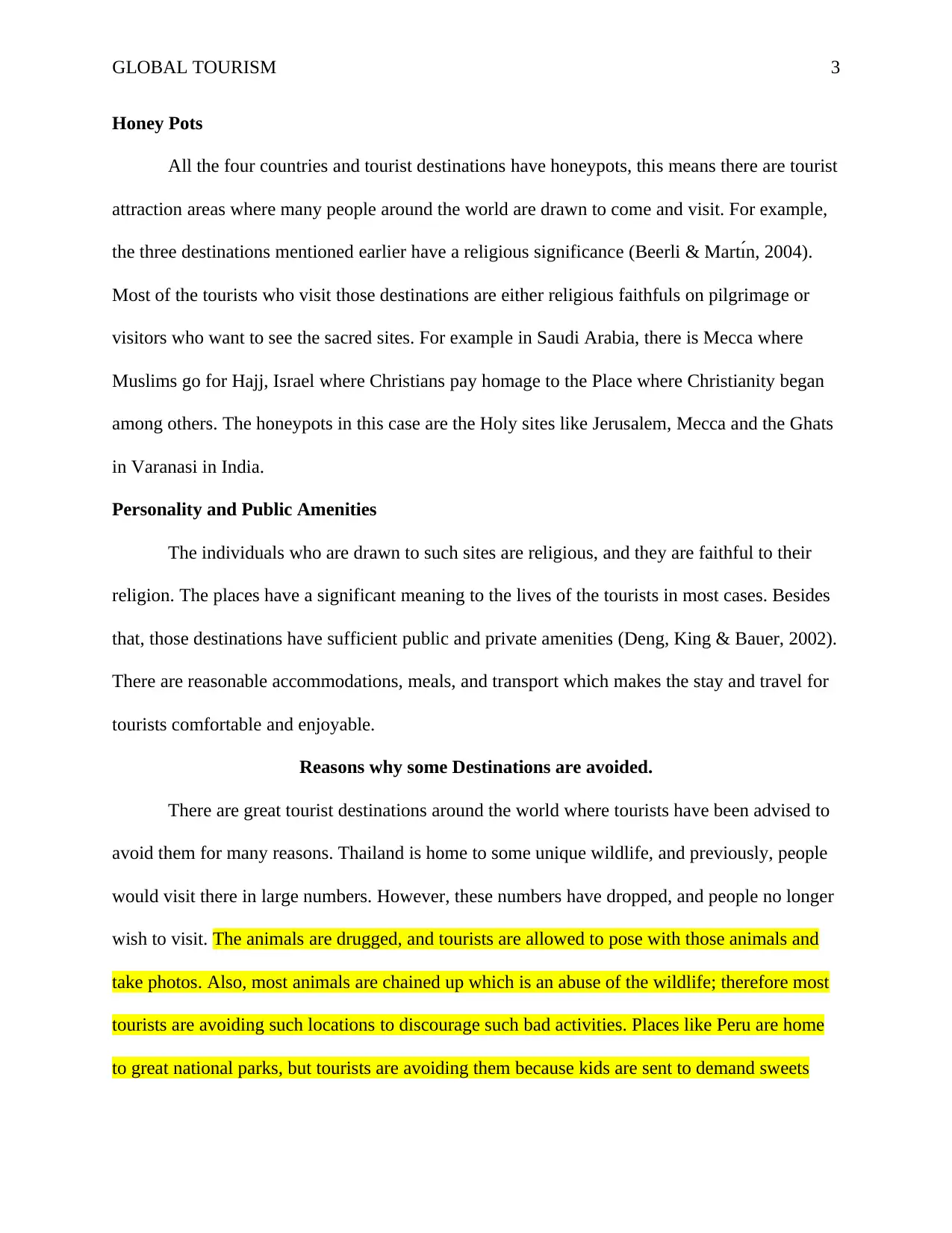
GLOBAL TOURISM 3
Honey Pots
All the four countries and tourist destinations have honeypots, this means there are tourist
attraction areas where many people around the world are drawn to come and visit. For example,
the three destinations mentioned earlier have a religious significance (Beerli & Martı́n, 2004).
Most of the tourists who visit those destinations are either religious faithfuls on pilgrimage or
visitors who want to see the sacred sites. For example in Saudi Arabia, there is Mecca where
Muslims go for Hajj, Israel where Christians pay homage to the Place where Christianity began
among others. The honeypots in this case are the Holy sites like Jerusalem, Mecca and the Ghats
in Varanasi in India.
Personality and Public Amenities
The individuals who are drawn to such sites are religious, and they are faithful to their
religion. The places have a significant meaning to the lives of the tourists in most cases. Besides
that, those destinations have sufficient public and private amenities (Deng, King & Bauer, 2002).
There are reasonable accommodations, meals, and transport which makes the stay and travel for
tourists comfortable and enjoyable.
Reasons why some Destinations are avoided.
There are great tourist destinations around the world where tourists have been advised to
avoid them for many reasons. Thailand is home to some unique wildlife, and previously, people
would visit there in large numbers. However, these numbers have dropped, and people no longer
wish to visit. The animals are drugged, and tourists are allowed to pose with those animals and
take photos. Also, most animals are chained up which is an abuse of the wildlife; therefore most
tourists are avoiding such locations to discourage such bad activities. Places like Peru are home
to great national parks, but tourists are avoiding them because kids are sent to demand sweets
Honey Pots
All the four countries and tourist destinations have honeypots, this means there are tourist
attraction areas where many people around the world are drawn to come and visit. For example,
the three destinations mentioned earlier have a religious significance (Beerli & Martı́n, 2004).
Most of the tourists who visit those destinations are either religious faithfuls on pilgrimage or
visitors who want to see the sacred sites. For example in Saudi Arabia, there is Mecca where
Muslims go for Hajj, Israel where Christians pay homage to the Place where Christianity began
among others. The honeypots in this case are the Holy sites like Jerusalem, Mecca and the Ghats
in Varanasi in India.
Personality and Public Amenities
The individuals who are drawn to such sites are religious, and they are faithful to their
religion. The places have a significant meaning to the lives of the tourists in most cases. Besides
that, those destinations have sufficient public and private amenities (Deng, King & Bauer, 2002).
There are reasonable accommodations, meals, and transport which makes the stay and travel for
tourists comfortable and enjoyable.
Reasons why some Destinations are avoided.
There are great tourist destinations around the world where tourists have been advised to
avoid them for many reasons. Thailand is home to some unique wildlife, and previously, people
would visit there in large numbers. However, these numbers have dropped, and people no longer
wish to visit. The animals are drugged, and tourists are allowed to pose with those animals and
take photos. Also, most animals are chained up which is an abuse of the wildlife; therefore most
tourists are avoiding such locations to discourage such bad activities. Places like Peru are home
to great national parks, but tourists are avoiding them because kids are sent to demand sweets
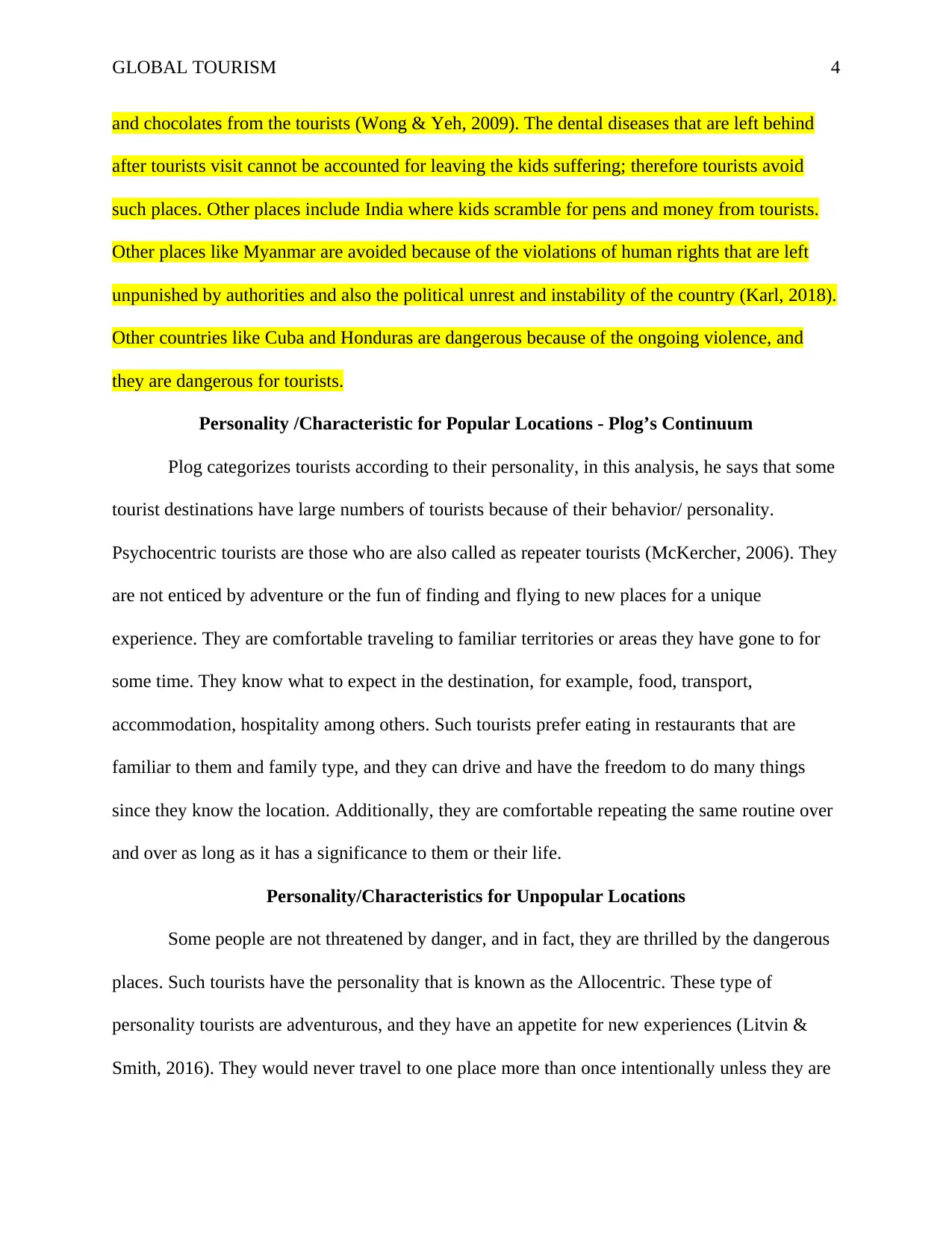
GLOBAL TOURISM 4
and chocolates from the tourists (Wong & Yeh, 2009). The dental diseases that are left behind
after tourists visit cannot be accounted for leaving the kids suffering; therefore tourists avoid
such places. Other places include India where kids scramble for pens and money from tourists.
Other places like Myanmar are avoided because of the violations of human rights that are left
unpunished by authorities and also the political unrest and instability of the country (Karl, 2018).
Other countries like Cuba and Honduras are dangerous because of the ongoing violence, and
they are dangerous for tourists.
Personality /Characteristic for Popular Locations - Plog’s Continuum
Plog categorizes tourists according to their personality, in this analysis, he says that some
tourist destinations have large numbers of tourists because of their behavior/ personality.
Psychocentric tourists are those who are also called as repeater tourists (McKercher, 2006). They
are not enticed by adventure or the fun of finding and flying to new places for a unique
experience. They are comfortable traveling to familiar territories or areas they have gone to for
some time. They know what to expect in the destination, for example, food, transport,
accommodation, hospitality among others. Such tourists prefer eating in restaurants that are
familiar to them and family type, and they can drive and have the freedom to do many things
since they know the location. Additionally, they are comfortable repeating the same routine over
and over as long as it has a significance to them or their life.
Personality/Characteristics for Unpopular Locations
Some people are not threatened by danger, and in fact, they are thrilled by the dangerous
places. Such tourists have the personality that is known as the Allocentric. These type of
personality tourists are adventurous, and they have an appetite for new experiences (Litvin &
Smith, 2016). They would never travel to one place more than once intentionally unless they are
and chocolates from the tourists (Wong & Yeh, 2009). The dental diseases that are left behind
after tourists visit cannot be accounted for leaving the kids suffering; therefore tourists avoid
such places. Other places include India where kids scramble for pens and money from tourists.
Other places like Myanmar are avoided because of the violations of human rights that are left
unpunished by authorities and also the political unrest and instability of the country (Karl, 2018).
Other countries like Cuba and Honduras are dangerous because of the ongoing violence, and
they are dangerous for tourists.
Personality /Characteristic for Popular Locations - Plog’s Continuum
Plog categorizes tourists according to their personality, in this analysis, he says that some
tourist destinations have large numbers of tourists because of their behavior/ personality.
Psychocentric tourists are those who are also called as repeater tourists (McKercher, 2006). They
are not enticed by adventure or the fun of finding and flying to new places for a unique
experience. They are comfortable traveling to familiar territories or areas they have gone to for
some time. They know what to expect in the destination, for example, food, transport,
accommodation, hospitality among others. Such tourists prefer eating in restaurants that are
familiar to them and family type, and they can drive and have the freedom to do many things
since they know the location. Additionally, they are comfortable repeating the same routine over
and over as long as it has a significance to them or their life.
Personality/Characteristics for Unpopular Locations
Some people are not threatened by danger, and in fact, they are thrilled by the dangerous
places. Such tourists have the personality that is known as the Allocentric. These type of
personality tourists are adventurous, and they have an appetite for new experiences (Litvin &
Smith, 2016). They would never travel to one place more than once intentionally unless they are
Secure Best Marks with AI Grader
Need help grading? Try our AI Grader for instant feedback on your assignments.
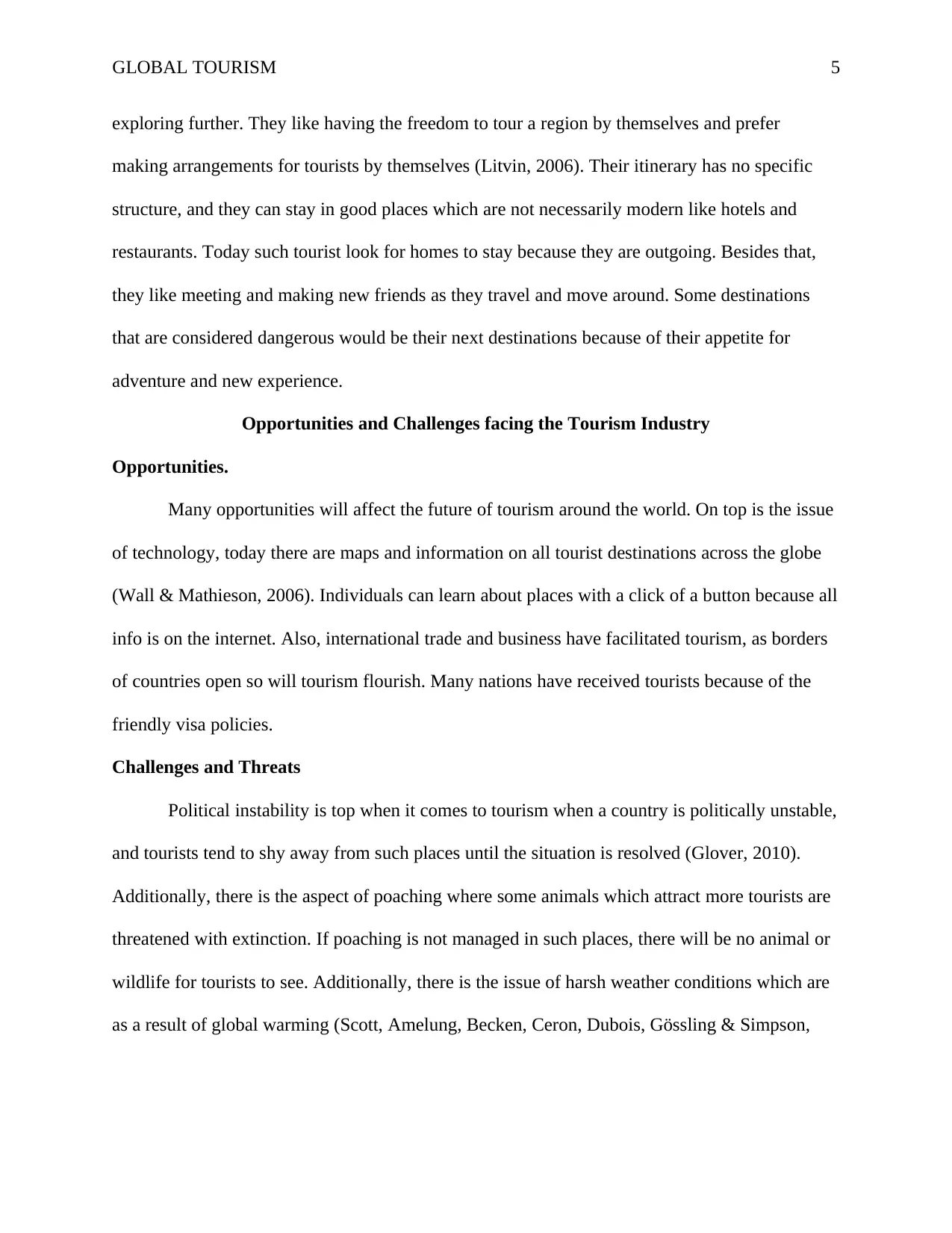
GLOBAL TOURISM 5
exploring further. They like having the freedom to tour a region by themselves and prefer
making arrangements for tourists by themselves (Litvin, 2006). Their itinerary has no specific
structure, and they can stay in good places which are not necessarily modern like hotels and
restaurants. Today such tourist look for homes to stay because they are outgoing. Besides that,
they like meeting and making new friends as they travel and move around. Some destinations
that are considered dangerous would be their next destinations because of their appetite for
adventure and new experience.
Opportunities and Challenges facing the Tourism Industry
Opportunities.
Many opportunities will affect the future of tourism around the world. On top is the issue
of technology, today there are maps and information on all tourist destinations across the globe
(Wall & Mathieson, 2006). Individuals can learn about places with a click of a button because all
info is on the internet. Also, international trade and business have facilitated tourism, as borders
of countries open so will tourism flourish. Many nations have received tourists because of the
friendly visa policies.
Challenges and Threats
Political instability is top when it comes to tourism when a country is politically unstable,
and tourists tend to shy away from such places until the situation is resolved (Glover, 2010).
Additionally, there is the aspect of poaching where some animals which attract more tourists are
threatened with extinction. If poaching is not managed in such places, there will be no animal or
wildlife for tourists to see. Additionally, there is the issue of harsh weather conditions which are
as a result of global warming (Scott, Amelung, Becken, Ceron, Dubois, Gössling & Simpson,
exploring further. They like having the freedom to tour a region by themselves and prefer
making arrangements for tourists by themselves (Litvin, 2006). Their itinerary has no specific
structure, and they can stay in good places which are not necessarily modern like hotels and
restaurants. Today such tourist look for homes to stay because they are outgoing. Besides that,
they like meeting and making new friends as they travel and move around. Some destinations
that are considered dangerous would be their next destinations because of their appetite for
adventure and new experience.
Opportunities and Challenges facing the Tourism Industry
Opportunities.
Many opportunities will affect the future of tourism around the world. On top is the issue
of technology, today there are maps and information on all tourist destinations across the globe
(Wall & Mathieson, 2006). Individuals can learn about places with a click of a button because all
info is on the internet. Also, international trade and business have facilitated tourism, as borders
of countries open so will tourism flourish. Many nations have received tourists because of the
friendly visa policies.
Challenges and Threats
Political instability is top when it comes to tourism when a country is politically unstable,
and tourists tend to shy away from such places until the situation is resolved (Glover, 2010).
Additionally, there is the aspect of poaching where some animals which attract more tourists are
threatened with extinction. If poaching is not managed in such places, there will be no animal or
wildlife for tourists to see. Additionally, there is the issue of harsh weather conditions which are
as a result of global warming (Scott, Amelung, Becken, Ceron, Dubois, Gössling & Simpson,
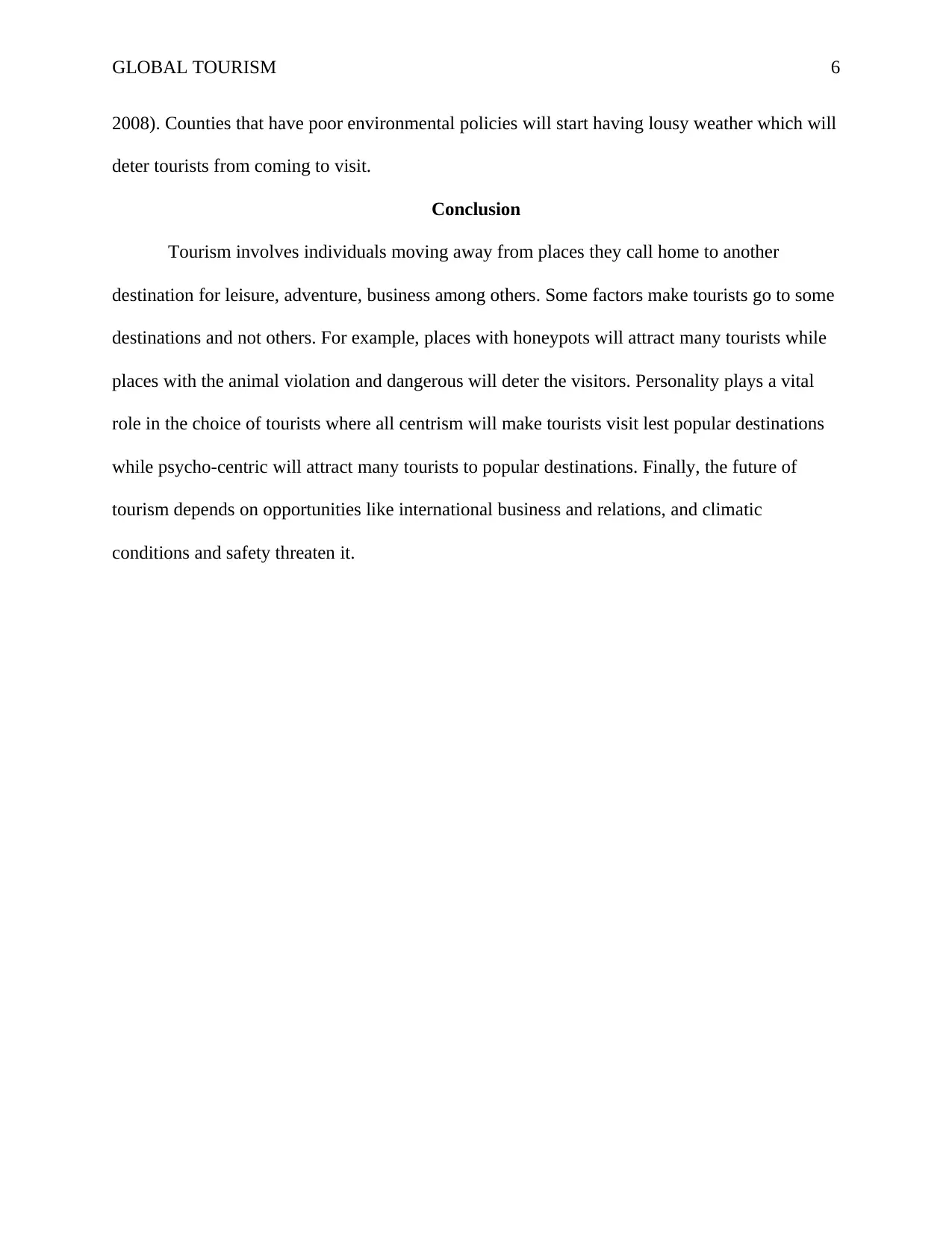
GLOBAL TOURISM 6
2008). Counties that have poor environmental policies will start having lousy weather which will
deter tourists from coming to visit.
Conclusion
Tourism involves individuals moving away from places they call home to another
destination for leisure, adventure, business among others. Some factors make tourists go to some
destinations and not others. For example, places with honeypots will attract many tourists while
places with the animal violation and dangerous will deter the visitors. Personality plays a vital
role in the choice of tourists where all centrism will make tourists visit lest popular destinations
while psycho-centric will attract many tourists to popular destinations. Finally, the future of
tourism depends on opportunities like international business and relations, and climatic
conditions and safety threaten it.
2008). Counties that have poor environmental policies will start having lousy weather which will
deter tourists from coming to visit.
Conclusion
Tourism involves individuals moving away from places they call home to another
destination for leisure, adventure, business among others. Some factors make tourists go to some
destinations and not others. For example, places with honeypots will attract many tourists while
places with the animal violation and dangerous will deter the visitors. Personality plays a vital
role in the choice of tourists where all centrism will make tourists visit lest popular destinations
while psycho-centric will attract many tourists to popular destinations. Finally, the future of
tourism depends on opportunities like international business and relations, and climatic
conditions and safety threaten it.
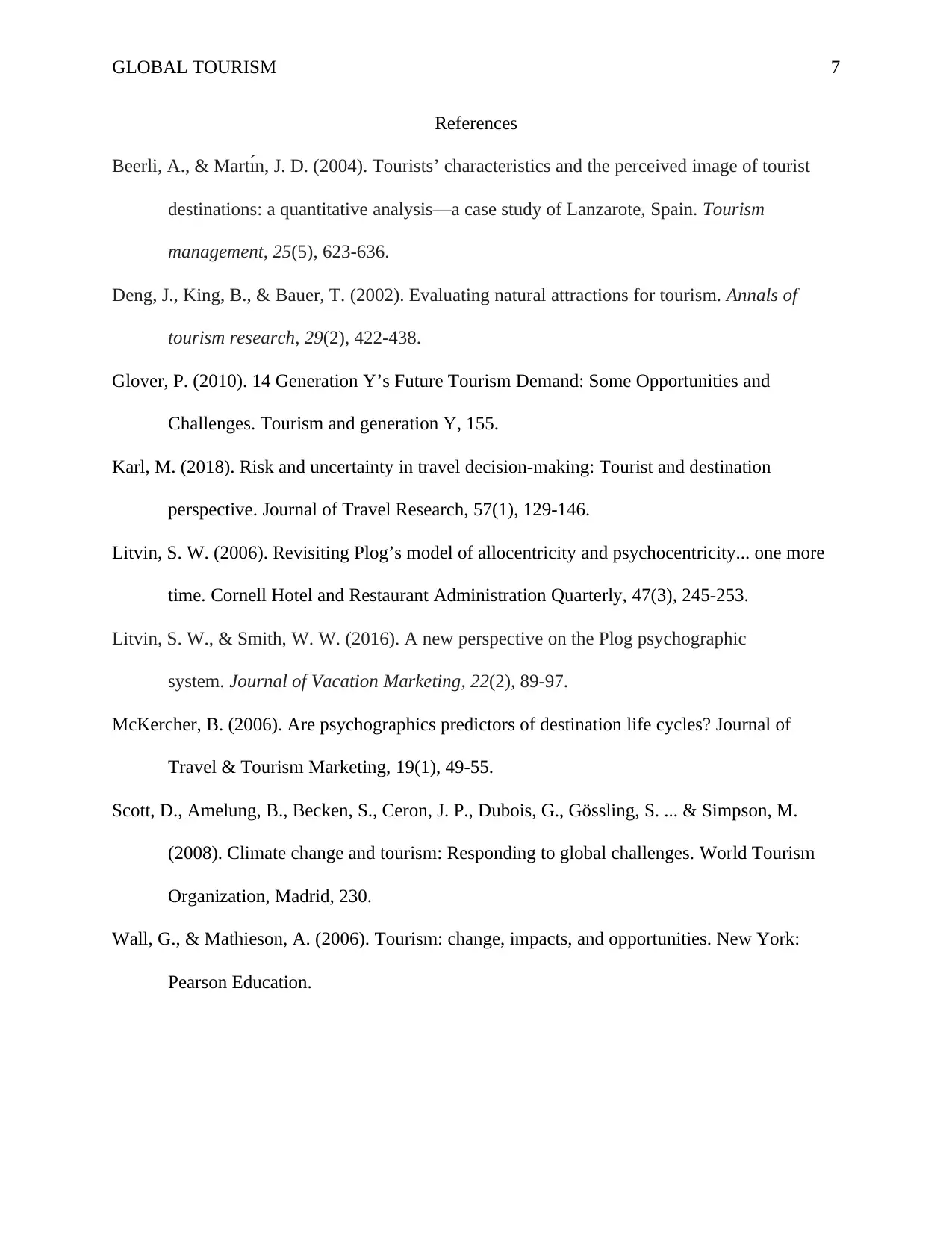
GLOBAL TOURISM 7
References
Beerli, A., & Martı́n, J. D. (2004). Tourists’ characteristics and the perceived image of tourist
destinations: a quantitative analysis—a case study of Lanzarote, Spain. Tourism
management, 25(5), 623-636.
Deng, J., King, B., & Bauer, T. (2002). Evaluating natural attractions for tourism. Annals of
tourism research, 29(2), 422-438.
Glover, P. (2010). 14 Generation Y’s Future Tourism Demand: Some Opportunities and
Challenges. Tourism and generation Y, 155.
Karl, M. (2018). Risk and uncertainty in travel decision-making: Tourist and destination
perspective. Journal of Travel Research, 57(1), 129-146.
Litvin, S. W. (2006). Revisiting Plog’s model of allocentricity and psychocentricity... one more
time. Cornell Hotel and Restaurant Administration Quarterly, 47(3), 245-253.
Litvin, S. W., & Smith, W. W. (2016). A new perspective on the Plog psychographic
system. Journal of Vacation Marketing, 22(2), 89-97.
McKercher, B. (2006). Are psychographics predictors of destination life cycles? Journal of
Travel & Tourism Marketing, 19(1), 49-55.
Scott, D., Amelung, B., Becken, S., Ceron, J. P., Dubois, G., Gössling, S. ... & Simpson, M.
(2008). Climate change and tourism: Responding to global challenges. World Tourism
Organization, Madrid, 230.
Wall, G., & Mathieson, A. (2006). Tourism: change, impacts, and opportunities. New York:
Pearson Education.
References
Beerli, A., & Martı́n, J. D. (2004). Tourists’ characteristics and the perceived image of tourist
destinations: a quantitative analysis—a case study of Lanzarote, Spain. Tourism
management, 25(5), 623-636.
Deng, J., King, B., & Bauer, T. (2002). Evaluating natural attractions for tourism. Annals of
tourism research, 29(2), 422-438.
Glover, P. (2010). 14 Generation Y’s Future Tourism Demand: Some Opportunities and
Challenges. Tourism and generation Y, 155.
Karl, M. (2018). Risk and uncertainty in travel decision-making: Tourist and destination
perspective. Journal of Travel Research, 57(1), 129-146.
Litvin, S. W. (2006). Revisiting Plog’s model of allocentricity and psychocentricity... one more
time. Cornell Hotel and Restaurant Administration Quarterly, 47(3), 245-253.
Litvin, S. W., & Smith, W. W. (2016). A new perspective on the Plog psychographic
system. Journal of Vacation Marketing, 22(2), 89-97.
McKercher, B. (2006). Are psychographics predictors of destination life cycles? Journal of
Travel & Tourism Marketing, 19(1), 49-55.
Scott, D., Amelung, B., Becken, S., Ceron, J. P., Dubois, G., Gössling, S. ... & Simpson, M.
(2008). Climate change and tourism: Responding to global challenges. World Tourism
Organization, Madrid, 230.
Wall, G., & Mathieson, A. (2006). Tourism: change, impacts, and opportunities. New York:
Pearson Education.
Paraphrase This Document
Need a fresh take? Get an instant paraphrase of this document with our AI Paraphraser

GLOBAL TOURISM 8
Wong, J. Y., & Yeh, C. (2009). Tourist hesitation in destination decision making. Annals of
Tourism Research, 36(1), 6-23.
Wong, J. Y., & Yeh, C. (2009). Tourist hesitation in destination decision making. Annals of
Tourism Research, 36(1), 6-23.
1 out of 8
Related Documents
Your All-in-One AI-Powered Toolkit for Academic Success.
+13062052269
info@desklib.com
Available 24*7 on WhatsApp / Email
![[object Object]](/_next/static/media/star-bottom.7253800d.svg)
Unlock your academic potential
© 2024 | Zucol Services PVT LTD | All rights reserved.





